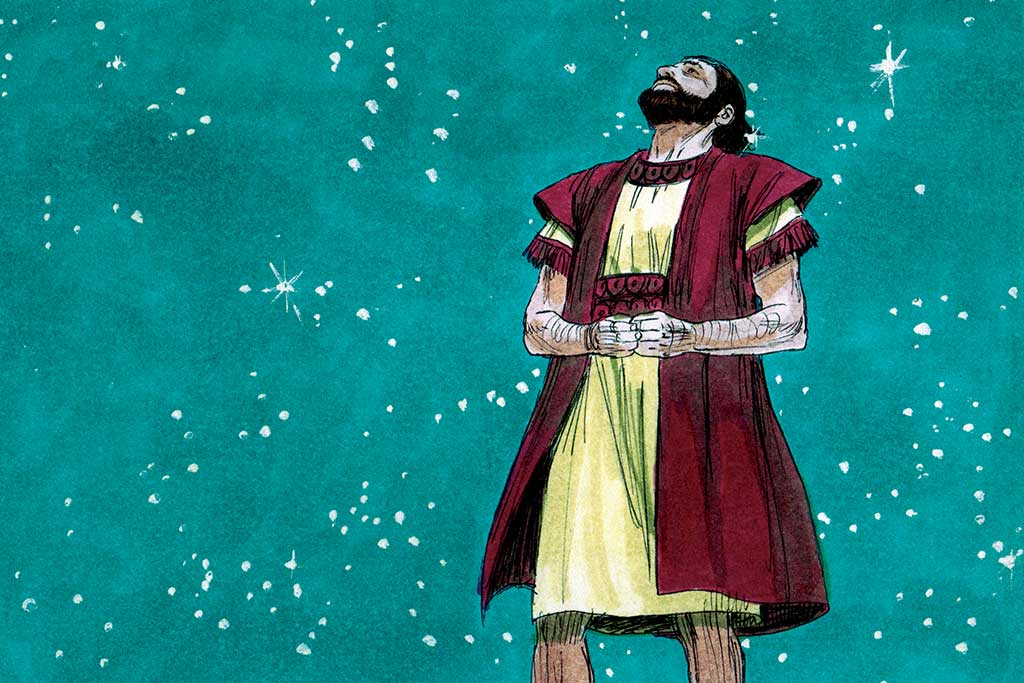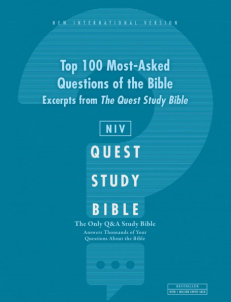
Adam and Eve
Is there any more controversial couple in the history of the world than the first couple, Adam and Eve? Is there any couple in the Bible in which we see more of ourselves?
If they grew up in church, Adam and Eve’s is the first Bible story that many people heard about as children. Church attenders of a certain age remember cartoon renderings of this couple dressed in fig leaves or hiding behind bushes from their Sunday school fliers; those who are younger will remember the account of the world’s first couple as the first story in their children’s Bible storybook. But wherever they are first encountered, the accounts of this first couple and their family have fascinated billions of people from around the world since the first time this story was passed down.
The images are colorful and incredible: Adam, the first man, formed from the dust, lives alone in an earthly paradise. He has plenty of food, is surrounded by beautiful foliage and animal companions as far as the eye can see and exists in perfect relationship with the very God who created him.
And yet, even in this optimal situation, something was missing. God himself declared the fact that Adam was alone “not good” (Genesis 2:18). So he hatched a plan to create Adam’s perfect companion: he would take a rib out of Adam himself and create a woman. Adam sleeps, then wakes up, and there is Eve.
Anyone who has ever been in a relationship understands how difficult they can be, even under the best circumstances. It truly fires the imagination to think of Adam and Eve happily working in the garden, side by side, with animals all around, enjoying all the good things imaginable to any couple living in such a perfect garden paradise.
Everything was so, so good. Until it wasn’t.
The Genesis account has a lot to say about this famous pair, who are legendary in their early mistakes and who, according to the Bible, are responsible for humanity’s fall from grace.
Were Adam and Eve Real People?
While this excellent question has been debated for centuries, the purpose of this post is not to argue whether Adam and Eve were actual individuals. Entire schools of thought featuring some of the world’s most brilliant biblical scholars have developed this argument well beyond the scope of this article. But we can glean some information from recent scholarship that is helpful in this regard.
John Walton, in his excellent commentary in the NIV Cultural Backgrounds Study Bible, writes about the question of Adam and Eve as individuals when he says,
In Genesis 2 there are archetypal elements that are identifiable. Man is made from the dust, and since he will also return to dust (Genesis 3:19), all people can be seen as created from the dust (see Psalms 103:14). The creation of Eve from Adam’s side (Genesis 2:21–23) likewise expresses a relationship between man and woman that permeates the race. In these Adam and Eve are archetypes representing all of humanity in their creation, just as they do in their sin and their destiny (death) in Genesis 3. Their function as archetypes does not suggest that they are not historical individuals; it only suggests that they function more importantly as representatives of the race.[1]
But let’s go back to the original source and for the purposes of this discussion; let’s look at what the Bible’s book of Genesis actually says about Adam and Eve.
What Genesis Says About Adam and Eve
The first few chapters of this book reveal the following about these two people, whom it portrays as actual individuals who became parts of a connected whole—the two people who would come together to form the basis for the rest of humanity. This is the account of God’s creation of mankind, from Genesis 1:
Then God said, “Let us make mankind in our image, in our likeness, so that they may rule over the fish in the sea and the birds in the sky, over the livestock and all the wild animals, and over all the creatures that move along the ground.”
So God created mankind in his own image,
in the image of God he created them;
male and female he created them.
God blessed them and said to them, “Be fruitful and increase in number; fill the earth and subdue it. Rule over the fish in the sea and the birds in the sky and over every living creature that moves on the ground.” (Genesis 1:26-28)
This is what we learn about the creation of Adam, from Genesis 2 and 3:
Then the Lord God formed a man from the dust of the ground and breathed into his nostrils the breath of life, and the man became a living being.
Now the Lord God had planted a garden in the east, in Eden; and there he put the man he had formed. (Genesis 2:7-8)
The Lord God took the man and put him in the Garden of Eden to work it and take care of it. And the Lord God commanded the man, “You are free to eat from any tree in the garden; but you must not eat from the tree of the knowledge of good and evil, for when you eat from it you will certainly die.” (Genesis 2:15-17)
Continuing on, this is the account of God’s creation of Eve, from Genesis 2:
The Lord God said, “It is not good for the man to be alone. I will make a helper suitable for him.”
Now the Lord God had formed out of the ground all the wild animals and all the birds in the sky. He brought them to the man to see what he would name them; and whatever the man called each living creature, that was its name. So the man gave names to all the livestock, the birds in the sky and all the wild animals.
But for Adam no suitable helper was found. So the Lord God caused the man to fall into a deep sleep; and while he was sleeping, he took one of the man’s ribs and then closed up the place with flesh. Then the Lord God made a woman from the rib he had taken out of the man, and he brought her to the man.
The man said,
“This is now bone of my bones
and flesh of my flesh;
she shall be called ‘woman,’
for she was taken out of man.” (Genesis 2:18-23)
Again, here we have two people living in absolutely perfect conditions. These two were happily communing with their Creator, seemingly immune to the conflicts that those of us who are in committed relationships (or, for that matter, any relationship with any other person) can find so frustrating and difficult.
So were Adam and Eve really like us? That hardly seems possible given the optimal relational circumstances they found themselves in. However, the Bible does say that we are, like Adam and Eve were, made in the image of God.
The Image of God in the First Humans
Critical to the understanding of who Adam and Eve were—and, by association, who we are as well—are the statements that discuss God’s decision to make “mankind in his own image, in the image of God . . . male and female he created them” (Genesis 1:27).
What does it mean that mankind was made in the image of God?
John Walton, again in the NIV Cultural Backgrounds Study Bible, writes about the idea of being made “in the image” of something that will help inform our discussion. He writes about Genesis 1:26, which says, “Then God said, ‘Let us make mankind in our image, in our likeness, so that they may rule over the fish in the sea and the birds in the sky, over the livestock and all the wild animals, and over all the creatures that move along the ground.’”
Walton asserts:
The biblical view is … people were created in the image of God, embodying his qualities and doing his work. They are symbols of his presence and act on his behalf as his representatives. The two words used in the text differ in nuance. “Image” refers to the something that contains the “essence” of something else, while “likeness” is more connected to “substance,” expressing a resemblance at some level.[2]
Richard Phillips, writing for The Gospel Coalition, further expands on this idea:
Just as Seth bore the “likeness and image” of his father Adam (Genesis 5:3), God made Adam and Eve to bear his image and likeness. Historical theology has often grounded the image of God in mankind’s superiority over lesser creatures, given man’s higher rationality and spirituality, and especially in human’s capacity to know and worship God. Further reflection notes that as “male and female,” mankind bears God’s image in a community of love. The emphasis in Genesis 1:26 on man’s dominion above the other creatures argues for mankind’s viceregency in accountability to God.
New Testament reflection on the divine image highlights that [humanity] was made for covenant communion with God in righteousness and holiness. While the Fall has marred the image of God – shattering the righteousness and holiness in which we were first made – God sent his Son, Jesus Christ, to redeem mankind and restore the image of God “in true righteousness and holiness” (Ephesians 4:24).[3]
So we see in Adam and Eve the likeness of God in many ways; a likeness that we still reflect today. Humans are set apart from the animals that were created in that we
• have a capacity to know God,
• to work for his purposes in the world,
• to love God and one another, and
• to be held accountable to God for the ways we follow his commands (or don’t).
The Fall: What Was It and Why Does It Matter?
Now let’s take a look at what the Bible says in Genesis about Adam and Eve’s fabled fall from God’s good graces:
Now the serpent was more crafty than any of the wild animals the Lord God had made. He said to the woman, “Did God really say, ‘You must not eat from any tree in the garden’?”
The woman said to the serpent, “We may eat fruit from the trees in the garden, but God did say, ‘You must not eat fruit from the tree that is in the middle of the garden, and you must not touch it, or you will die.’”
“You will not certainly die,” the serpent said to the woman. “For God knows that when you eat from it your eyes will be opened, and you will be like God, knowing good and evil.”
When the woman saw that the fruit of the tree was good for food and pleasing to the eye, and also desirable for gaining wisdom, she took some and ate it. She also gave some to her husband, who was with her, and he ate it. Then the eyes of both of them were opened, and they realized they were naked; so they sewed fig leaves together and made coverings for themselves.
Then the man and his wife heard the sound of the Lord God as he was walking in the garden in the cool of the day, and they hid from the Lord God among the trees of the garden. But the Lord God called to the man, “Where are you?”
He answered, “I heard you in the garden, and I was afraid because I was naked; so I hid.”
And he said, “Who told you that you were naked? Have you eaten from the tree that I commanded you not to eat from?”
The man said, “The woman you put here with me—she gave me some fruit from the tree, and I ate it.”
Then the Lord God said to the woman, “What is this you have done?”
The woman said, “The serpent deceived me, and I ate.” (Genesis 3:1-13)
As was written in the introduction to this essay, things in the Garden of Eden were good. Until they weren’t. The serpent, God’s only opponent in the Garden, confronted this couple, questioning the promises God had made to them. And Adam and Eve took the bait.
Old Testament scholar Michael Williams describes the fall in poetic terms when he writes,
Our estrangement from God began with Adam and Eve’s willful sin against him in choosing to listen to the serpent rather than God. They ate a malignant poison that found its way into every area of our beings. Now sin is part of our human nature. It was not originally so, but is now a continual and pervasive presence that corrupts that nature. As a result, every human being has sinned and continues to sin.[4]
Another biblical scholar, Albert Mohler, says the following about these two individuals:
“When Adam sinned, he sinned for all of us. And it’s that very sinfulness that sets up our understanding of our need for a Savior.”
Mohler says the Adam and Eve story is not just about a fall from paradise: It goes to the heart of Christianity. He notes that the Apostle Paul (in Romans 5 and 1 Corinthians 15) argued that the whole point of Jesus’ crucifixion and resurrection was to undo Adam’s original sin.
“Without Adam, the work of Christ makes no sense whatsoever in Paul’s description of the Gospel, which is the classic description of the Gospel we have in the New Testament,” Mohler says.[5]
In these statements, we see the following realities about Adam and Eve as the archetypes of who we are as Adam and Eve’s descendants today:
1. Adam and Eve were created by God for a purpose;
2. God gave Adam and Eve specific rules about what was to be done in the creation he had given them;
3. Adam and Eve made a decision to not follow those rules;
4. our world today, and every single one of us as individuals, still feel the effects of their decision.
So what do we do with the reality of the fall and sin in the world? Who gets the blame for everything that’s gone wrong since the beginning of time? Do we just pass it off on Adam and Eve as being naïve and weak? Or do we see in Adam and Eve the potential for rebellion and sin that is resident in all of our hearts?
Seeing Ourselves in the First Couple
Consider the following ways in which we see in their story more of our story—and how these factors have been perpetuated in the world since the beginning of creation. How does each of these relate to your life today?
• Adam and Eve were made in God’s image. Each of us is as well.
• Adam and Eve were loved by God and companions of God in the garden of Eden. In the same way, God loves each one of us and wants to be a part of our lives. The prophet Jeremiah quotes God as saying, “You will seek me and find me when you seek me with all your heart” (Jeremiah 29:13). God desires to have a relationship with us, and makes that relationship possible through the birth, death, and resurrection of his only Son Jesus.
• Adam and Eve tangled with the tempter and lost. How much do we see that in our own lives, in our own day and age? It seems like the temptations to sin are so much greater now than they ever could have been in the garden, but in Adam and Eve’s temptation we see the same questioning of God’s goodness that grows the very same fruit of sin in our lives. As the serpent made Adam and Eve question God’s goodness, so also when we give in to temptation, we ask the same question: “Would a good God really keep this thing from me?” Whatever temptation we face, the serpent still whispers the same questions in our ears and assures us, “You will not surely die!” And, like our first parents, we believe that to be true.
• Adam and Eve fell into sin, and we still bear the scars of that fall. The apostle Paul says, “There is no one righteous, not even one; there is no one who understands; there is no one who seeks God. All have turned away, they have together become worthless; there is no one who does good, not even one” (Romans 3:10-12). Apart from Jesus, the One sinless Sacrifice for our sin, that means every person who has ever or will ever live is steeped in sin. Case closed.
• Adam and Eve had relational differences and family strife. For those of us who are married or are otherwise in relationships, who can imagine the discussions that went on after this first couple was expelled from the garden? Who blamed who? How does a couple move forward in their life together when literal paradise has been lost? (Read the story in Genesis 3:8-24.)
• Adam and Eve experienced the harshness of hard work and the difficulty of living in a fallen world. You can read about the “curse” (a word we’ll come back to later on) in Genesis 3:16-24.
• Adam and Eve experienced the harsh reality of death early on. Who can imagine the agony of these two parents coming upon that first murder, when Adam and Eve’s son Cain murdered his brother Abel? The story of the world’s first murder is as chilling as any “true crime” documentary or podcast we can stream today. In the same way, every one of us has been or will be touched by the cruel reality of losing a loved one. (Read the story in Genesis 4:1-16.)
Finally,
• Adam and Eve couldn’t atone for their own sin; they needed God’s help as much as we do. God looked ahead to the promise of salvation for his people very early on in the Garden of Eden when he declared that a descendant of Eve would crush the head of the serpent (Genesis 3:15). And God sent his Son, Jesus, to pay for the sin of Adam and Eve, as well as the sins of the rest of humanity.
What Does the Rest of the Bible Say About Adam and Eve?
The Bible memorializes our first parents essentially by remembering their fall into sin. It has as much to say about the pervasive nature of sin in the world as it does about the sin into which we’re all personally born.
The apostle Paul describes in various ways the origins of our sinful nature in his writings to the churches:
Therefore, just as sin entered the world through one man, and death through sin, and in this way death came to all people, because all sinned . . . death reigned from the time of Adam to the time of Moses, even over those who did not sin by breaking a command, as did Adam, who is a pattern of the one to come. (Romans 5:12-14)
We are so much like the first couple; we see their sinfulness in ourselves. But in that painful reality we are not without hope, for Paul also writes,
But the gift is not like the trespass. For if the many died by the trespass of the one man, how much more did God’s grace and the gift that came by the grace of the one man, Jesus Christ, overflow to the many! (Romans 5:15)
For as in Adam all die, so in Christ all will be made alive. (1 Corinthians 15:22)
So it is written: “The first man Adam became a living being”; the last Adam, a life-giving spirit. The spiritual did not come first, but the natural, and after that the spiritual. The first man was of the dust of the earth; the second man is of heaven. As was the earthly man, so are those who are of the earth; and as is the heavenly man, so also are those who are of heaven. And just as we have borne the image of the earthly man, so shall we bear the image of the heavenly man. (1 Corinthians 15:45-49)
Since, then, you have been raised with Christ, set your hearts on things above, where Christ is, seated at the right hand of God. Set your minds on things above, not on earthly things. For you died, and your life is now hidden with Christ in God. When Christ, who is your life, appears, then you also will appear with him in glory. (Colossians 3:1-4)
When we commit ourselves to following Jesus Christ as our Lord and Savior, we move from one pattern to the other. We change from being focused on our fallen, earthly nature and are free to examine what it means to bear more and more the image of God, the creator of Adam and Eve, and of every individual who has ever, or will ever, live on the earth. Paul writes about this in 2 Corinthians 5:17 when he says, “Therefore, if anyone is in Christ, the new creation has come: The old has gone, the new is here!”
Those of us who have accepted Jesus’ offer of salvation have help, through the power of Jesus’ own Holy Spirit, to become more and more like him as we work to influence others to follow him. When we invite the Spirit’s influence into our lives and pray for opportunities to do God’s work in the world, we can participate with billions of others over the ages who have, however imperfectly, stepped forward in God’s name to turn back some of the power of sin in the world.
Adam and Eve believed the lie. We as Christians today have the entire Bible at our disposal to help us understand the various forms that lie takes. Knowing that we carry the same sin-sickness as our most distant ancestors, we can pray that God himself will prepare us to battle against the sin in our own hearts as we prepare for the kingdom that is to come as described in John’s final letter:
Then I saw “a new heaven and a new earth,” for the first heaven and the first earth had passed away, and there was no longer any sea. I saw the Holy City, the new Jerusalem, coming down out of heaven from God, prepared as a bride beautifully dressed for her husband. And I heard a loud voice from the throne saying, “Look! God’s dwelling place is now among the people, and he will dwell with them. They will be his people, and God himself will be with them and be their God. ‘He will wipe every tear from their eyes. There will be no more death’ or mourning or crying or pain, for the old order of things has passed away.” He who was seated on the throne said, “I am making everything new!” Then he said, “Write this down, for these words are trustworthy and true.” (Revelation 21:1-5)
Regarding the “curse” from earlier in this essay, John has this to say:
No longer will there be any curse. The throne of God and of the Lamb will be in the city, and his servants will serve him. They will see his face, and his name will be on their foreheads. There will be no more night. They will not need the light of a lamp or the light of the sun, for the Lord God will give them light. And they will reign for ever and ever. (Revelation 22:3-5)
No more curse. No more sin. No more pain or sorrow or disease or weeping. No more relational conflict. Once again we will see in ourselves the similarities to Adam and Eve; however, at this point in time we will all, in blessed community with God, experience the same perfect conditions that our first parents experienced in the Garden before the serpent ever whispered a syllable.
Then we will experience being made in the “image and likeness” of God, but in an absolutely true and pure and perfect sense. We will reflect his image as he originally intended as we work with him and worship him forever. Imagine how incredible that will be!
He who testifies to these things says, “Yes, I am coming soon.”
Amen. Come, Lord Jesus. (Revelation 22:20)
By Mike Vander Klipp, a senior editor with the Zondervan Bible Group, where he’s been privileged to work for the past three decades. He and his family live in Grand Rapids, Michigan.
¹Notes on Genesis 2:7 in the NIV Cultural Backgrounds Study Bible. Grand Rapids, MI, Zondervan, 2016.
²Notes on Genesis 1:26 in the NIV Cultural Backgrounds Study Bible. Grand Rapids, MI, Zondervan, 2016.
³https://www.thegospelcoalition.org/essay/man-as-the-image-of-god/
⁴Michael Williams, blog post entitled, “Atonement: How the Impossible was Made Possible, August, 2023.
⁵National Public Radio: Evangelicals Question the Existence Of Adam and Eve: August 9, 2011 (Heard on Morning Edition)
Find an NIV Bible that’s right for you! There’s an NIV Bible for every age and need – Bibles for study, devotions, journaling, classic reference, large print, youth, and more. Find yours today!






